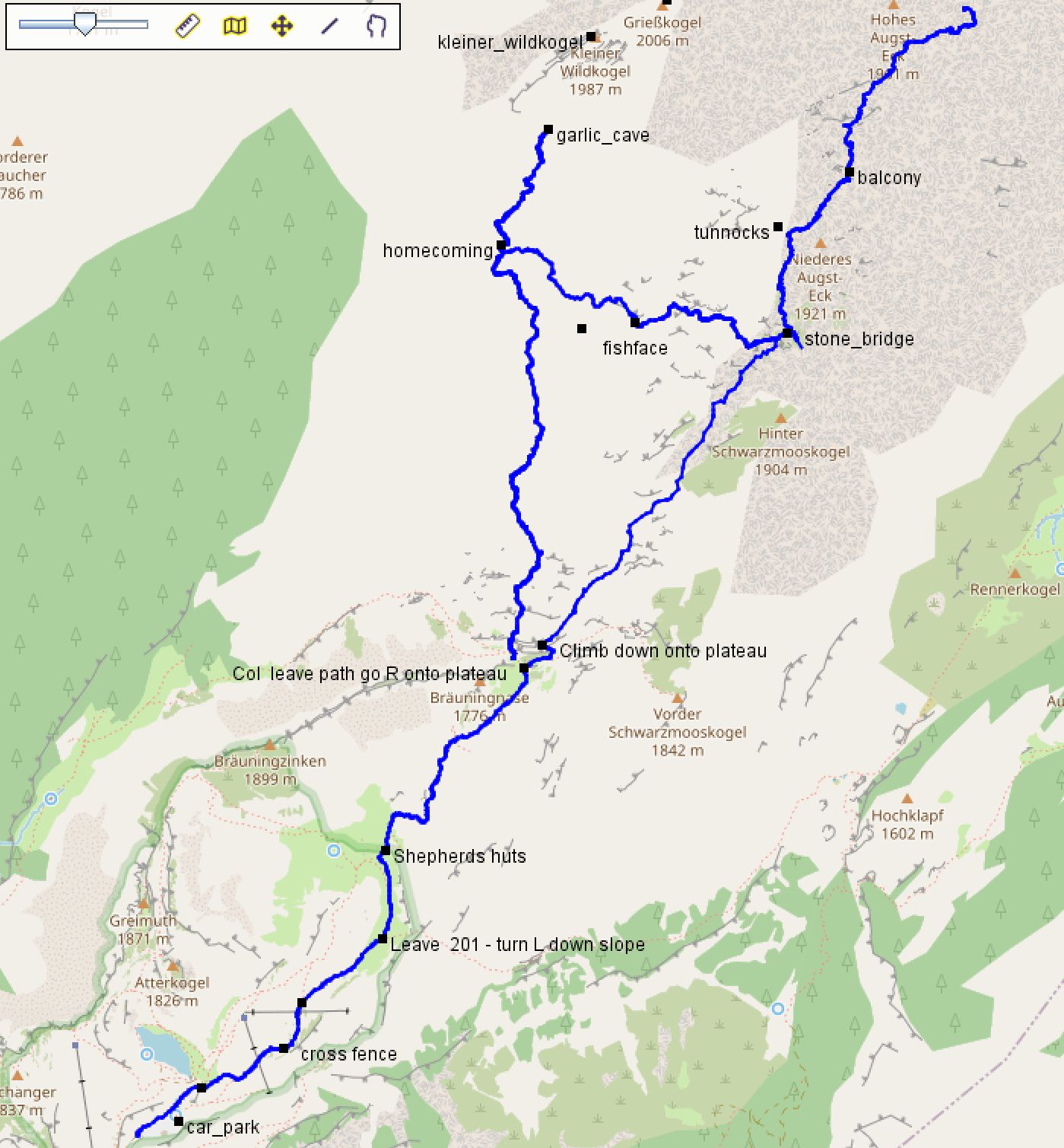
SAFETY. Everyone gets lost on the plateau.
Don't get lost for long as this causes rescue plans to be initiated.
Don't be misled by the apparent simplicity of the tracks. The plateau is very broken and is an unremitting extent of cliffs, holes and impassable dwarf-larch scrub ("bunde" as it is known on expo). You can be 5m from the route and have lost it entirely. The walk to and from col leading to the plateau is comparatively easy is it is an obvious path, and marked and signposted in the earlier section.

There is no such thing as a quick installation procedure for iPhones. The prefered app is gaia GPS.
If the quick start doesn't work for you, go to the general instructions further down this page.
When using your phone for prospecting for new caves, or refinding old entrances, there are two further usefull files that you should consider downloading:
If you are looking for how to upload one of your own GPS tracks, go to gpxupload.
The OsmAnd documentation says:
More documentation on this to follow...
Install a GPS app (e.g. OSMand) first.
Do one of
or, if you can't get those to work
| GPX format | KML format | ZIP of both |
|---|---|---|
| essentials2024 | essentials2024.kml | essentials2024.zip |
| entrances2024 | - | - |
| kataster-boundaries-as-tracks | - | - |
| essentials (downloads as XML) | essentials.kml | essentials.zip |
BEFORE you download the gpx file, install OSMand on your phone. Then, when the download happens, you will be prompted as to which app you want to use to veiw the file and you can select OSMand - but only if you installed OSMand first.
Use the links in the table at the top of the page.
This is easy on a laptop, but phone browsers make it difficult to download a simple link like that - just clicking will usually (unhelpfully) display it in the browser.
You need to long-click and pick 'download file' or 'download link' (chrome). Then either:
This is where it gets tricky because every device and phone app does this differently.
This should work the same way whether you have an iPhone or an Android phone.
We recommended OsmAnd as it is very capable, but you can use others.
On android phones, this may be best achieved by installing from F-Droid rather than the plan store
Connect the GPS device to your laptop (or the expo laptop) using the USB cable. A folder will open on the laptop showing the contents of the device. You will see a subfolder called "GARMIN". Open the folder "GARMIN" and copy the file essentials.gpx which you downloaded into that folder.
Even modern (2019) Garmin GPS devices use this old style mini-USB socket. So you will need the special cable that comes with the device. An ordinary phone USB cable won't work.

These need the Garmin communication protocol to import cave entrance locations (waypoints) and paths (tracks). You can't do it by simply copying files. This means that you need special software on your laptop in addition to a USB cable that connects your laptop to the Garmin device.
Once you have the right cable and connected your handheld to your laptop:
We create a new version of this essential GPS data during expo and as expoers discover new entrances and devise new routes to reach them.
To regenerate the most recent version which contains the cave entrances discovered during expo you will need to ask someone who is competent in logging into the server and running scripts.
The data is in the version control system repository :loser: in
loser/gpx/and is generated from the survex data by a script. It is best to do this on a laptop which has the entire :loser: repo downloaded onto it (e.g. the expo laptop) rather than on the server itself as the server can run out of memory doing this.
The most recent track data will have been uploaded by an expoer into e.g.
expofiles/gpslogs/2019/MichaelSargent/col-to-homecoming-msargent-2019-07-14_18-38_Sun.gpx
and this will need to be hand-edited into script-generated essentials.gpx file.
There are two scripts needed for this: make_essentials.sh and make_svx.sh both of which are stored in the :loser: repository in :loser:/gpx/ .
Read the README file in that directory.
They are documented in the long list of Other scripts.